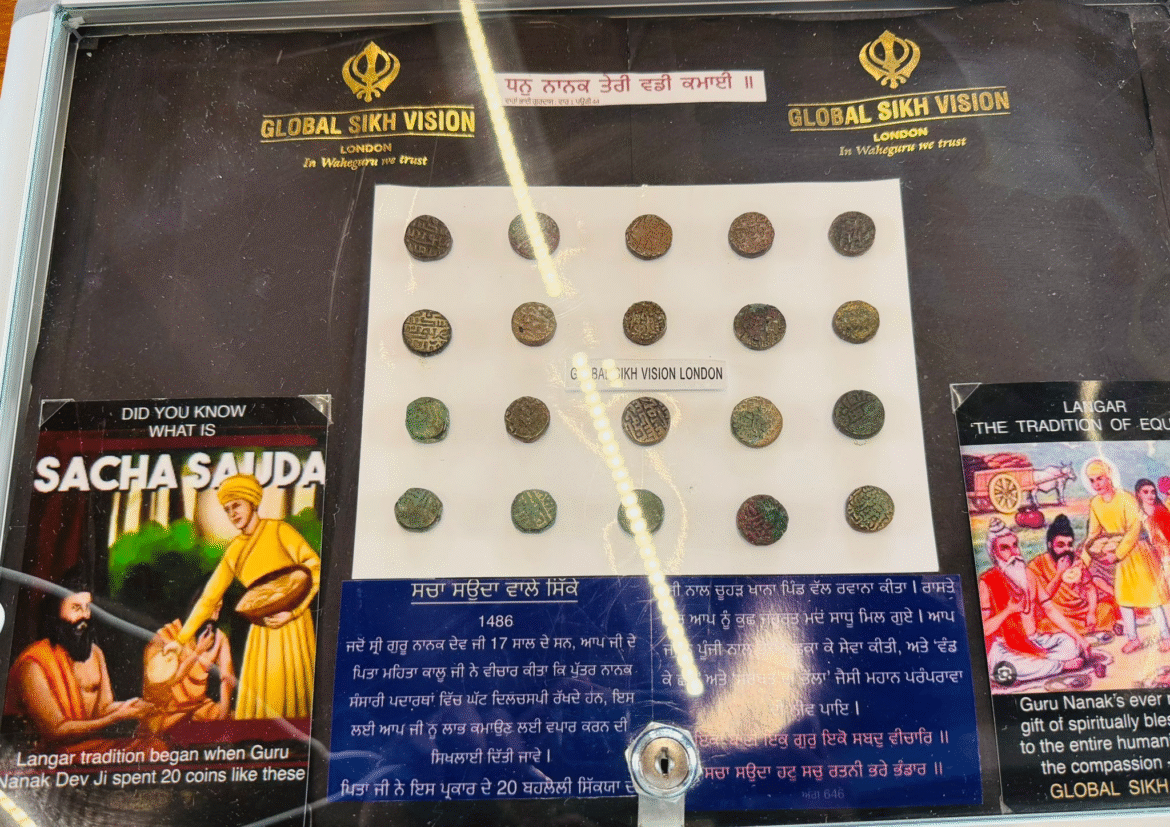AI Generated Summary
- Here, under the patronage of Bhai Sahib (Dr) Mohinder Singh Ahluwalia OBE KSG, Chair of GNNSJ, and in collaboration with Dr Davinder Singh of The Kalgidhar Trust, a unique exhibition invited visitors on a journey not only through time—but through the values that shaped a faith.
- The display includes copper coins believed to represent the exact denomination Guru Nanak Sahib used for the Sacha Sauda, his selfless act of service at age 18 that laid the foundation for the Sikh practice of langar.
- As Birmingham’s Sikh diaspora engages with the future, Coins of Courage is a compelling reminder that the past is not just something to study—but something to live by.
On a typical Saturday, the Guru Nanak Nishkam Sewak Jatha (GNNSJ) complex on Soho Road hums with familiar energy: families gather, hymns of Gurbani echo through the halls, and warm langar is served to all. But this Saturday held something special—an event that merged the power of education with the depth of history, offering a rare glimpse into Sikh heritage through a most unexpected medium: coins.
While a major conference titled “Unpacking Gurmat Education” convened scholars and educators just steps away, a smaller adjacent hall quietly housed a treasure trove of Sikh legacy. Here, under the patronage of Bhai Sahib (Dr) Mohinder Singh Ahluwalia OBE KSG, Chair of GNNSJ, and in collaboration with Dr Davinder Singh of The Kalgidhar Trust, a unique exhibition invited visitors on a journey not only through time—but through the values that shaped a faith.
A Personal History Turned Public Exhibit
Curated by Ravinder Pal Singh Kohli, a UK-based Sikh originally from Rawalpindi, the exhibition—entitled Coins of Courage—is the result of decades of inheritance, research, and dedication. The artefacts on display are not government-owned nor borrowed from national museums. Instead, they come from Kohli’s own family archives, passed down through generations since the pre-Partition era.
Presented under his non-profit Global Sikh Vision, the collection spans nearly four centuries—from the birth of Guru Nanak in 1469 to the British annexation of Punjab in 1849. Each coin, shell, or metallic fragment tells a story, not just of currency, but of courage, community, and continuity.
Metal that Speaks
The display includes copper coins believed to represent the exact denomination Guru Nanak Sahib used for the Sacha Sauda, his selfless act of service at age 18 that laid the foundation for the Sikh practice of langar. Other relics highlight significant turning points: silver coins tied to Makhan Shah Lubana’s identification of Guru Tegh Bahadur; gold mohurs used to purchase land for the cremation of the Chhote Sahibzade after their martyrdom in Sirhind; and coins minted during the violent persecutions under Governor Mir Mannu.
The collection is arranged meticulously, tracing Sikh history through phases: from the era of the ten Gurus, to Baba Banda Singh Bahadur’s short-lived sovereignty, through the Misl confederacies, and into the grandeur of Maharaja Ranjit Singh’s rule.
What makes this more than a numismatic exhibition is the cultural narrative inscribed in every object. Coins featuring images of the Khanda and Kirpan stand not as militaristic emblems, but as statements of self-defense and spiritual resilience. Inscriptions like “Sat” (truth) and “Akal Sahai” (God is the helper) offer insight into the values etched into Sikh life—literally and symbolically.
Pluralism in Pocket Form
Strikingly, some coins carry not just Sikh symbols but those from other communities, a quiet testament to Punjab’s pluralistic ethos under Sikh leadership. Early coinage is inscribed in Farsi, while later issues begin to include Gurmukhi script—tracing a subtle shift toward cultural self-expression and linguistic pride.
From the Marketplace to the Mind
The exhibition’s resonance was amplified by its setting. Just next door, religious educators and spiritual leaders discussed the future of Gurmat-based learning—how to build not just intellectual capacity, but moral character in children. In the coin room, that philosophy was alive in historical form. Each coin was a reflection of how Sikh values once permeated daily life, even in commerce.
Together, both the exhibition and the conference painted a powerful picture: one of a community grounded in memory and motivated by mission. As Birmingham’s Sikh diaspora engages with the future, Coins of Courage is a compelling reminder that the past is not just something to study—but something to live by.
The exhibit may be tucked in a quiet room, but its impact resounds far beyond its walls—an archive of metal, yes, but more so, an archive of meaning.




